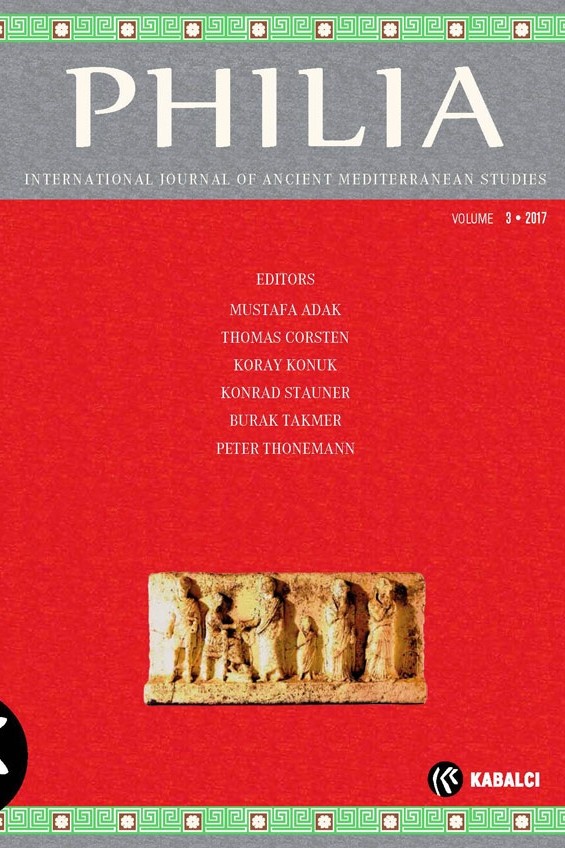*Idyris Rüzgarı, Idyros ve Endyrenos Nehirleri ve Likyalı Ñturiga
Yazar makalesinde Eski Yunanca bir yazıtta belgelenen “Endyrenos” nehir adının, Proto Hint-Avrupa *en dhur “içeride” sözcüğüne kadar geri giden Likçe *endur- kökünden geldiğini öner-mektedir. Yazara göre Eski Yunan edebi metinlerinde geçen Idyros nehir adı ve bununla bağlantılı Idyris rüzgâr adı, Lidcede belgelenen *ẽ- > i- ses gelişimi yoluyla aynı kökten geliyor olmalıdır. Ya-zar ayrıca söz konusu nehrin ve rüzgârın doğarak dar bir boğazdan geçtikleri “orman çanağı”nın aynı zamanda bu adlandırmayı da açıkladığını düşünmektedir. Yazar makalesini Likçe bir yazıtta belgelenen ve ön ses düşmesine uğrayan Ñturiga şahıs adının da (hatalı bir sözcük ayrımına dayan-sa da) *endur- kökünden gelebileceği iddiasıyla tamamlamaktadır.
Vom Wind *Idyris, den Flüssen Idyros und Endyrenos und dem Lykier Ñturiga
The derivation of the river name Endyrenos, attested in a Greek inscription, is proposed to be from a Lycian *endur- going back to PIE *en dhur ‚indoors‘. The name of the river Idyros and the wind associated with it in Greek texts could be of the same origin, via an attested Lydian sound develo-pment *ẽ- > i-. And the „forest bowl“, out of which the river and the wind emerge through a narrow gorge, thus offers an explanation for this name. A third derivation of *endur- may be the personal name Ñturiga attested in a Lycian inscription (with wrong word division), showing aphaeresis.
Keywords:
Idyris, Idyros, Endyrenos, Ñturiga, Lycia, Lycian language, West Pamphylia,
___
- Adak 2008 M. Adak, Winde am Pamphylischen Golf, in: İ. Delemen et al. (Hrsgg.), Euergetes. Festschrift für Prof. Dr. Haluk Abbasoğlu zum 65. Geburtstag, Bd.1, Antalya 2008, 45–54.
- Borchhardt – Neumann 1968 J. Borchhardt – G. Neumann, Dynastische Grabanlagen von Kadyanda, AA 1968, 174–238.
- Brosch 2008 C. Brosch, Nominalkonposita und kompositionsähnliche Strukturen im appellativen Wortschatz des Hethitischen, Magisterarbeit Berlin 2008 (s. academia.edu).
- Kalinka 1901 E. Kalinka, Tituli Lyciae lingua Lycia conscripti (Tituli Asiae Minoris I), Wien 1901.
- Kloekhorst 2008 A. Kloekhorst, Etymological Dictionary of the Hittite Inherited Lexicon (Leiden Indo-European Etymological Dictionary Series, vol. 5), Leiden – Boston 2008.
- Melchert 2004 H. C. Melchert, A Dictionary of the Lycian Language, Ann Arbor – New York 2004.
- Mørkholm – Neumann 1978 O. Mørkholm – G. Neumann, Die lykischen Münzlegenden (Nachr. AW Göttingen, phil.-hist. Kl. 1/1978), Göttingen 1978.
- Neumann 1979 G. Neumann, Neufunde lykischer Inschriften seit 1901 (Denkschr. ÖAW, phil.-hist. Kl. 135), Wien 1979.
- Neumann – Zimmermann 2003 G. Neumann – M. Zimmermann, Die lykischen Götter der Agora. Neulesung der griechisch-lykischen Bilingue TL 72a-b in Kyaneai, in: F. Kolb (Hrsg.), Lykische Studien 6 (Asia Minor St. 48), Bonn 2003, 187–192.
- Rousset 2010 D. Rousset, De Lycie en Cabalide. La convention entre les Lyciens et Termessos près d’Oinoanda (Fouilles de Xanthos X, Hautes Études du Monde Gréco-Romain 45), Genève 2010.
- Schürr 1996 D. Schürr, Zur karischen Felsinschrift Si.62 F, Kadmos 35, 1996, 149–156.
- Schürr 2006a D. Schürr, Elf lydische Etymologien, in: R. Bombi et al. (Hrsgg.), Studi linguistici in onore di Roberto Gusmani, Alessandria 2006, 1569–1587.
- Schürr 2006b D. Schürr, Karische Berg- und Ortsnamen mit lykischem Anschluß, HS 119, 2006, 117–132.
- Schürr 2009 D. Schürr, Zwei atypische lykische Schreibungen, ÖNF 37, 2009, 105–119.
- Schürr 2010a D. Schürr, Zur Vorgeschichte Lykiens: Städtenamen in hethitischen Quellen, Klio 92/I, 2010, 7–33.
- Schürr 2010b D. Schürr, Spätkarisch: Regionalisierung und Lautentwicklungen, in: R. van Bremen – J.-M. Carbon (Hrsgg.), Hellenistic Karia. Proceedings of the First International Conference on Hellenistic Karia – Oxford, 29 June – 2 July 2006 (Ausonius Éditions, Études 28), Bordeaux 2010, 187–205.
- Schürr 2014 D. Schürr, Lykische Orte und ihre Namen: Drei Namentypen, in: P. Taracha – M. Kapełuś (Hrsgg.), Proceedings of the Eighth International Congress of Hit-ti¬¬tology, Warsaw, 5–9 September 2011, Warschau 2014, 743–774.
- Stark 1958 F. Stark, Alexander’s Path from Caria to Cilicia, London 1958.
- Şahin 2001 S. Şahin, Epigraphische Mitteilungen aus Antalya V. Olbia und einige andere Küstenorte bei Kemer in Westpamphylien, EA 33, 2001, 145–167.
- Tekoğlu 2002/3 R. Tekoğlu, Three New Lycian Inscriptions from Tlos and Asartaş, Die Sprache 43, 2002/3, 104–114.
- Zgusta 1964 L. Zgusta, Kleinasiatische Personennamen (Monografie Orientálního ústavu ČSAV 19), Prag 1964.
- ISSN: 2149-505X
- Başlangıç: 2015
- Yayıncı: Kabalcı Yayıncılık
Sayıdaki Diğer Makaleler
Troas’da Bir Hayalet Kent ve Sikke Darbı
Teos Mermer Ocakları ve Lucullus Mermeri
Lyrboton Kome’den Zeus Drymon’a Adaklar
Nikaia Egemenlik Alanından Yeni Bir ῥοδισμός Yazıtı
Mustafa ADAK, Hüseyin Sami ÖZTÜRK
Legio XII Fulminata’da optio olarak Askerlik Yapmış Olan C. Iulius’un Mezartaşı
*Idyris Rüzgarı, Idyros ve Endyrenos Nehirleri ve Likyalı Ñturiga
Lydia Kenti Saittai Üzerine Üç Not
